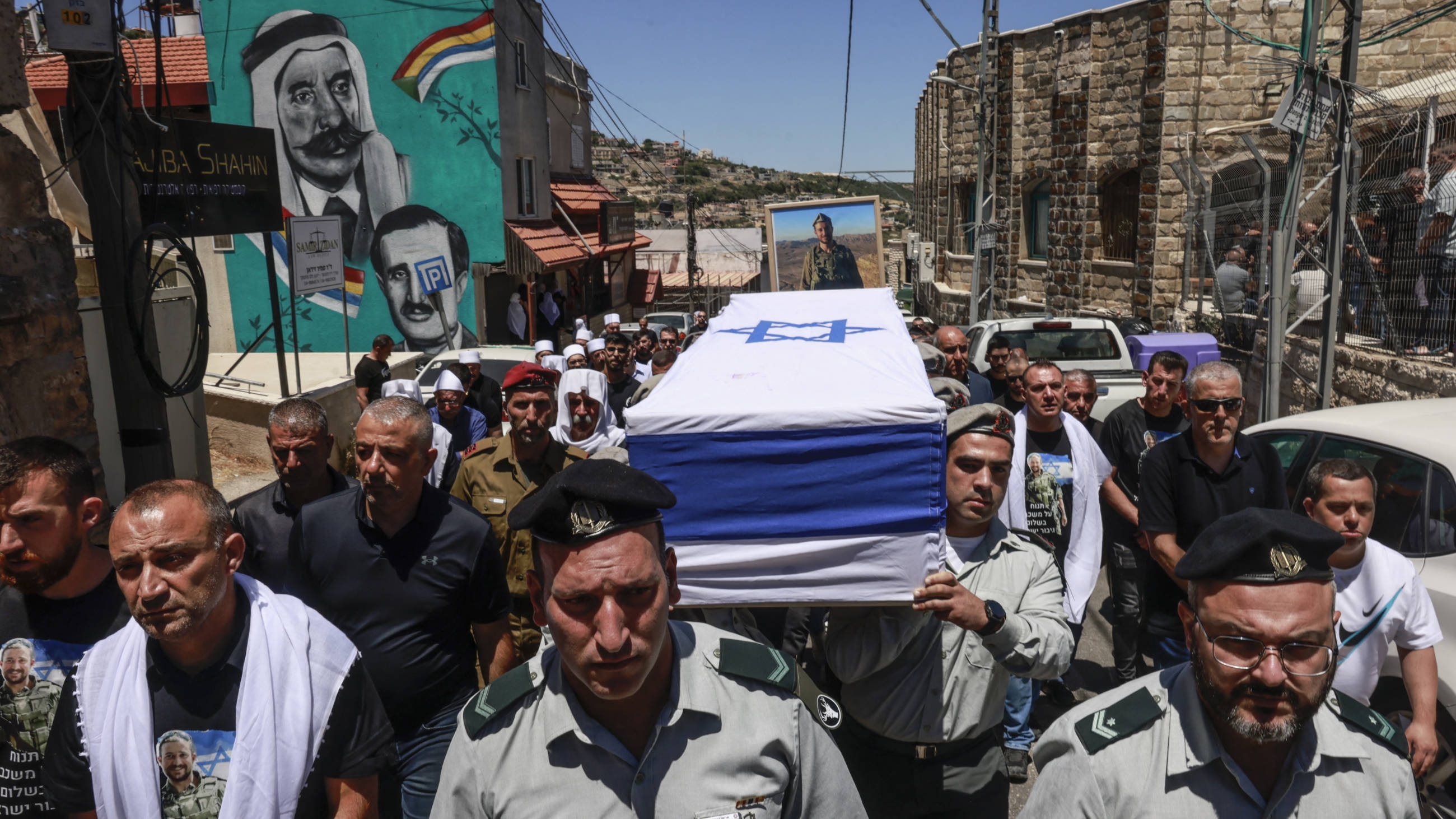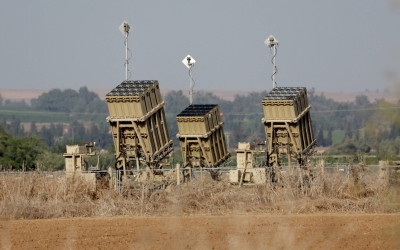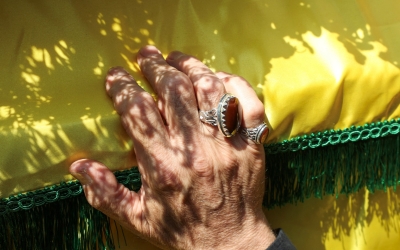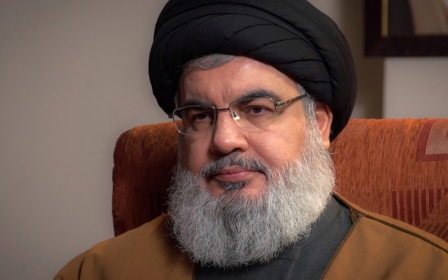Sight of Israeli Druze fighting in Gaza horrifies Lebanon's community

At a funeral procession for an Israeli Druze soldier killed in Gaza this week, mourners wore T-shirts bearing his face next to an Israeli flag. Loved ones kissed Wessam Mahmoud's casket, which was draped in the blue-and-white Star of David.
What was noticeable about the scene were the portraits of prominent Syrian and Lebanese Druze leaders seen adorning a wall as the procession passed through the Druze village of Beit Jann, in northern Israel.
The paintings of historic Syrian Druze figures Sultan al-Atrash and Lebanese Progressive Socialist Party (PSP) founder Kamal Jumblatt, an ardent advocate of Palestinians before his death in 1977, raised eyebrows in Lebanon, home to a significant Druze community.
“I am so ashamed of this image that Druze from Palestine are raising the portraits of Sultan Attrache and Kamal Jumblatt behind an Israeli flag covering the coffin of an IDF (Israeli army) soldier,” Walid Jumblatt, son of Kamal and a de facto leader of Lebanon’s Druze community, wrote on X a day later.
“What an insult to the memory of these two great Arab heroes,” he added in the post.
New MEE newsletter: Jerusalem Dispatch
Sign up to get the latest insights and analysis on Israel-Palestine, alongside Turkey Unpacked and other MEE newsletters
Mahmoud was killed fighting in the southern city of Rafah in Gaza, where the Israeli army has killed more than 37,000 Palestinians since October.
Contacted by MEE, Jumblatt declined to provide further comment.
“In every Israeli war, Druze [soldiers] die. There are many Druze in [Israeli] combat units,” Tobias Lang, a political scientist who has published research on the Druze of the Levant, said.
And though images of Sultan al-Atrash are common among Druze Israelis, Lang said, “I think what triggered Jumblatt was the usage of the pictures of his father. This is quite unusual. Memory is always selective - Kamal Jumblatt can be seen as a symbol of the Lebanese and pro-Palestinian left, and as a Druze leader, too."
But for Druze citizens of Israel, according to Lang, Kamal Jumblatt’s image is “not widely used.”
“It’s unusual to see Kamal Jumblatt’s picture in the context of the IDF.”
Split across battle lines
The Druze - an Arabic-speaking ethno-religious group present across the Levant - adhere to an offshoot of Islam that emerged in medieval Egypt and are found primarily in Syria, Lebanon and Israel.
There are about 150,000 Druze citizens of Israel, according to The Times of Israel, and another 24,000 in the Israeli-occupied Syrian Golan Heights who have rejected Israeli citizenship and live in a state of legal limbo. The latter “still regard the Syrian state as their home,” a Syrian journalist of Druze origin told Middle East Eye. He requested anonymity to protect family members still living in Syria.
Unlike Muslim and Christian Palestinian citizens of Israel, Druze male citizens have been drafted into the state’s mandatory military service since the 1950s, when Tel Aviv made efforts to integrate the community. It is not clear how many Israeli soldiers are Druze.
Druze are also listed as a separate nationality from Arabs under Israeli law, as the state facilitates a sense of “distinct Israeli Druze identity,” Lang said, “through the educational system, and of course through [military] conscription.”
This dynamic “comes from far before the current fight in Gaza,” the Syrian journalist said.
“It’s important to note, though, that Druze people in Palestine are not a monolith,” said Lebanese international criminal lawyer Nadine Kheshen, herself a member of the Druze community.
“In the Druze religion, there’s this principle that you’re supposed to assimilate with the population around you.” That means that some community members “assimilated with the occupation, while others have conscientiously objected to serving in the army and have gone to jail for it.”
And although through the years, Druze citizens of Israel have expressed some solidarity with their community in Lebanon and Syria, the feeling doesn’t tend to go both ways.
Druze for Palestinians
In the majority-Druze town of Baysour in the mountains above Beirut, about a dozen old semi-automatic rifles adorn the living room wall of Riyadh Malaeb in a neat row.
He said the guns are from his time as a PSP fighter during the Lebanese Civil War, including in the “War of the Mountain” sub-conflict in the early 1980s.
'We are not with those [people] who hold up Kamal Joumblatt’s photo in Israel'
- Riyadh Malaeb, Druze mayor
This pitted the PSP and leftist groups against the Christian Lebanese Forces, which were backed by Israel.
During that conflict, Malaeb gained his nomme de guerre Bahhar, “the Sailor”, by crossing the nearby Dammour River to fight “those working with Israel” on the other side.
Now deputy mayor of Baysour, Malaeb said he’s proud of his actions during the war, when he was a teenager.
“We are not with those [people] who hold up Kamal Jumblatt’s photo in Israel,” Malaeb said of the unusual display this past Sunday at the Israeli soldier Mahmoud’s funeral. “We are with the Palestinian people who are being massacred”.
Walid Jumblatt himself has also urged Druze south of the border not to take up arms against Palestinians in the wake of the 7 October Hamas-led attack on southern Israeli communities. In an X post on 8 October, he called on “the forced conscripts of the Druze Arabs into the Israeli army in occupied Palestine” not to take part in the war.
The fighting has come to include attacks on civilians, the bombing of hospitals, civilian homes and infrastructrure, houses of worship, and displacement camps, in war crimes being investigated by the International Court of Justice (ICJ) as potential genocide.
“It doesn’t matter if Druze fighters are technically indigenous, because they are fighting with the occupying power,” Kheshen said.
“So at the end of the day, they would be considered members of the occupation.”
An all-out Lebanon war?
Meanwhile, the risk of yet another all-out war between Lebanon and Israel is growing. Druze towns on both sides of the border have been hit.
At an Eid al-Adha gathering in Baysour earlier this week, politician Ghazi Aridi, a Druze former government minister and close associate of Jumblatt, suggested to local Druze sheikhs and notables that a fight in Lebanon - though already underway in the country’s south since October - could be devastating should it intensify.
“A war with Hezbollah is different from a war with Hamas,” he told locals over coffee at a private home after the town’s Eid religious ceremony. “Hamas is surrounded, whereas Hezbollah…” The discussion topic soon changed.
Aridi could not be reached for further comment.
The Israeli army announced on Tuesday that it had "approved and validated” plans for a potential offensive on Lebanon as cross-border attacks between Hezbollah and Israeli forces intensify.
Where do Jumblatt and the PSP stand in the midst of it all? The former PSP leader is seen as implicitly supporting Hezbollah should the air war in southern Lebanon grow into an all-out conflict with Israel.
“It’s going to be a long war. And it will probably be our turn soon,” Jumblatt told Qatari newspaper Al-Sharq in late May.
Middle East Eye delivers independent and unrivalled coverage and analysis of the Middle East, North Africa and beyond. To learn more about republishing this content and the associated fees, please fill out this form. More about MEE can be found here.







